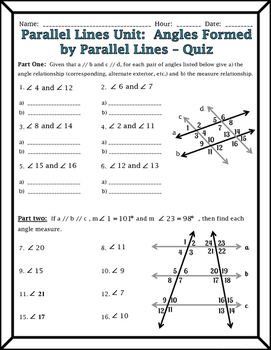Have you ever looked at a city grid and wondered how all those streets intersect so perfectly? Or maybe you’ve gazed at a railroad track and noticed how the rails seem to converge in the distance? These everyday scenes are visual representations of parallel lines and transversals, fundamental concepts in geometry that shape our world. In this article, we’ll explore the fascinating world of parallel lines and transversals, delving into their properties, understanding how they intersect, and ultimately unlocking the secrets behind their angle relationships.

Image: byveera.blogspot.com
Understanding parallel lines and transversals is crucial for anyone studying geometry. These concepts provide the foundation for solving a wide range of problems, from calculating the angles in a triangle to navigating complex architectural designs. As we navigate the principles of parallel lines and transversals, you’ll gain a deeper appreciation for the interconnectedness of geometric shapes and the logic behind their relationships.
The Foundation: Parallel Lines and Transversals
Parallel Lines
Imagine two straight lines that stretch infinitely in both directions and never intersect. That’s the essence of parallel lines! They are like two train tracks running side-by-side, maintaining a constant distance between them. Mathematically, parallel lines are represented by the symbol “||.” For instance, the notation “AB || CD” indicates that line AB is parallel to line CD.
Transversals: The Line That Cuts Across
Now, let’s introduce another line – a transversal! It’s a straight line that intersects two or more parallel lines. Think of a transversal as a crosswalk that cuts across parallel streets. This intersection creates a variety of angles, and understanding how these angles relate to each other is the key to grasping the essence of parallel lines and transversals.

Image: www.chegg.com
The Key Relationships: Identifying Angle Pairs
The intersection of transversals with parallel lines gives rise to unique angle relationships. These relationships are the foundation for solving geometric problems and understanding how angles interact. Here are the main types of angle pairs that we’ll explore:
Corresponding Angles
Imagine you’re standing at the intersection of a transversal and two parallel lines. Look at the angles that occupy matching positions on the same side of the transversal – these are called corresponding angles. They are like mirrors reflecting each other, always equal in measure. If one corresponding angle is 60 degrees, then its corresponding angle will also be 60 degrees.
Alternate Interior Angles
Now let’s focus on angles that lie between the parallel lines and are on opposite sides of the transversal. These are known as alternate interior angles. Picture them as “alternating” positions within the interior of the parallel lines. These angles are also equal in measure, just like corresponding angles.
Alternate Exterior Angles
Similar to alternate interior angles, but now we look at angles that are outside the parallel lines and on opposite sides of the transversal. These are alternate exterior angles, and they too are equal in measure.
Same-Side Interior Angles
Finally, consider angles that lie between the parallel lines and are on the same side of the transversal. These are called same-side interior angles. Unlike the other pairs, these angles are supplementary; they add up to 180 degrees. It’s like completing a puzzle – these angles fit together to form a straight angle.
Applying the Concepts: Real-World Examples
Parallel lines and transversals aren’t just abstract concepts; they’re everywhere in our world! Observe the following:
-
Architecture: Buildings often incorporate parallel lines and transversals in their construction. Think of the beams of a roof, the walls of a room, or the rows of windows in a skyscraper.
-
Engineering: Bridges, roads, and railroads rely on the principles of parallel lines and transversals for stability and efficient design.
-
Art and Design: Artists use parallel lines and transversals to create depth, perspective, and visual harmony in their paintings, drawings, and sculptures.
-
Nature: Even nature demonstrates parallel lines and transversals in the patterns of leaves on a tree, the stripes of a zebra, or the veins of a leaf.
2-7 Practice: Parallel Lines and Transversals Answer Key
Now, let’s put your knowledge to the test with some practice problems. Here are some common types of questions you might encounter in the 2-7 practice for parallel lines and transversals.
Example 1:
Given parallel lines AB and CD intersected by transversal EF, find the measure of angle x.
- Solution: Since angle x and the given angle are alternate interior angles, they are equal in measure. Therefore, angle x = 60 degrees.
Example 2:
Given parallel lines GH and IJ intersected by transversal KL, find the measure of angle y.
- Solution: Angle y and the given angle are same-side interior angles, which are supplementary. Therefore, they add up to 180 degrees. So, angle y = 180 – 120 = 60 degrees.
Example 3:
Given parallel lines MN and OP intersected by transversal QR, are angles z and w corresponding angles?
- Solution: Angles z and w are not corresponding angles. They are alternate exterior angles, which are equal in measure.
2-7 Practice Parallel Lines And Transversals Answer Key
Conclusion: Mastering the Interplay of Angles
By understanding parallel lines and transversals and how they create specific angle relationships, you’ve gained a powerful tool for solving geometric problems. This knowledge has practical applications in various fields, from architecture and engineering to art and design. It’s not just about knowing the formulas; it’s about seeing the geometry in action, in the world around you. So, the next time you look at a city grid, a railroad track, or a simple building, remember the elegance and logic of parallel lines and transversals. Keep exploring, and your understanding of geometry will continue to grow!
**Call to Action:** Share your experience with parallel lines and transversals below in the comments! Have you noticed any interesting applications in your daily life? Let’s continue to explore the fascinating world of geometry together!






